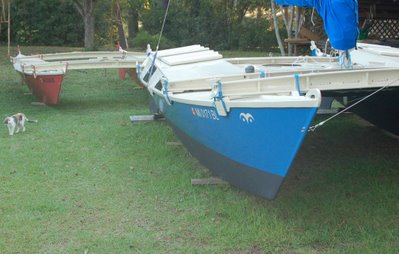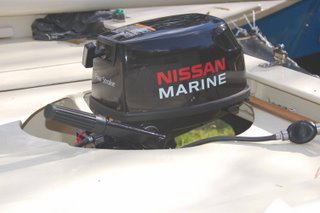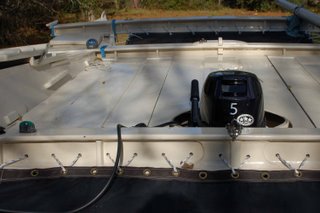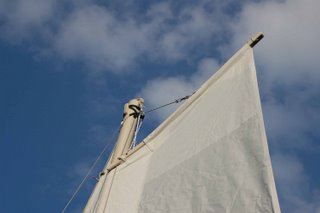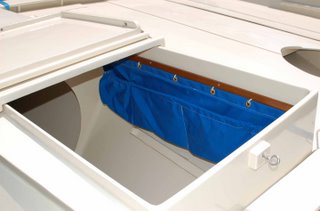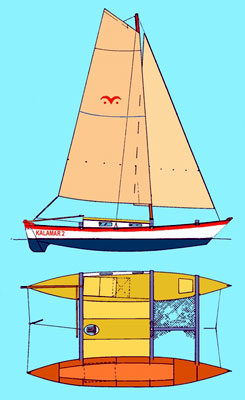I knew there was work to be done on this boat when I bought it, but even so, I thought I would be sailing it by now. As it turned out, the refit turned out to be an extensive one, as many of the necessary repairs revealed other problems I could not have seen until I started sanding through the paint and replacing rotten wood, etc. Some of these problems were the result of neglect; others were simply poor building practices on the part of the original builder. Many of the projects I’ve taken on and the changes I’ve made might not seem necessary to other Tiki 21 sailors, but rather than get in a hurry just to get on the water, I wanted to do everything I could to make this boat as strong and seaworthy as possible, and to make it look as good as possible considering what I had to work with. Each decision in the refit was made with long-term durability in mind, and with thoughts to making the boat ready for extended coastal voyaging.
Posting the details of the repairs here might help other Tiki 21 owners who are facing a similar job, or might help builders of new Tiki 21 catamarans make the right decisions regarding particular tasks so that future problems can be avoided. A lot of these problems could be avoided by using higher quality plywood and by sheathing EVERY exposed plywood surface in fiberglass cloth and epoxy.
Here is the list of jobs completed so far:
Built two strong dollies with pneumatic tires so that each hull could be moved when off the trailer and handled by one person.
Stripped the hardware and wooden end cleats off the three crossbeams and sanded them down to the bare wood. The previous owner had done a poor job of varnishing the top plates, despite discoloration in the wood from water intrusion. I cut off all the beam ends at the proper angle to match the curve of the deck, made new end cleats of teak installed with through bolts bedded in 3M 4200, and painted all parts of the beams and cleats the with the same Interlux Brightside “Off White” I will use for the decks.
Stripped and sanded the varnished mast down to the bare wood and filled minor cracks in the laminations. The builder used finger-jointed fir for the mast parts, so I decided to sheath the entire mast in 6-oz. fiberglass to make delamination less likely and to add some strength. After glassing the entire mast, including the crane and foot, I painted it all Off White. The gaff was also painted Off White.
Chiseled off the rotten trampoline rails on both port and starboard foredecks, and made new, stronger ones out of teak. I only used teak because I had it on hand. There will be no brightwork on this boat, so even teak parts such as this will be painted to blend in with the decks.
Chiseled off rotten bridgedeck support rails on the port and starboard inboard cabin sides and made new ones out of Douglas fir. I also replaced the jib sheet lead blocks above the deck support rails with new ones made of teak.
Discovered extensive areas of rot in the sheer stringers where the decks are nailed to the hulls on both the port and starboard hulls, both on the inboard and outboard sides. Chiseled all soft and wet sections out of these fir stringers and scarfed in new sections using Douglas fir and epoxy thickened with wood flour and silica. All new areas here were faired in to match the existing stringers with several rounds of sanding and filling. Then the repaired areas were all glassed with 6-oz. cloth which was also faired into existing decks.
Built up the hatch coamings on the foredeck hatches, and added a wide flange at the top to create a better sealing surface to make the hatches more watertight. I also added a wooden “dam” in front of each bow hatch to deflect green water coming over the deck while going to windward in the rough stuff. This should divert a lot of the water that otherwise would be forced under the hatch seals.
I did extensive sanding and fairing of poorly-finished deck and cabin-side surfaces left by the original builder. Fairing was done with epoxy mixed with West System microlight fairing compound and silica.
Laid out symmetrical patches of non-skid areas on the fore and aft decks of each hull, the cabin tops, and the middle bridge deck pieces. Non-skid surface was applied by mixing non-skid compound with the deck paint and applying in the taped-off areas with a 3-inch foam roller.
The beam and shroud lashing cleats were improperly placed on the sheer stringer by the original builder, not leaving enough overhang to get the full number of turns off lashing rope specified in the plans. To correct this problem, I squared off the bottom edges of all these cleats with a belt sander, then laminated blocks of solid mahogany to the bottom edges to get another half-inch of overhang. All this had to be reshaped and rounded over to avoid chafing the lashing lines, then epoxy coated, primed and painted.
Replaced the beam lashing lines with new Dacron 3’16” line by Sampson, using the solid blue color to match the hull topsides.
Rebuilt the two-piece main companionway hatches for each hull by cutting out rotten wood in the overhang edges and scarfing in new sections. Hatches were showing bad signs of checking, since they were made of Douglas fir marine plywood but were only epoxy coated and painted rather than sheathed in fiberglass. Sanded all these down to bare wood and properly sheathed, faired and painted them Off White to match the decks.
Bow storage compartment hatches were also repaired and sheathed in fiberglass and painted. All hatches were also stripped and painted on the inside, in preparation for new foam hatch seal tape for a better seal.
I’m not sure why so many builders think they know more than Wharram, but like many of them, the builder of my Tiki hung the rudders on gudgeons and pintles, rather than lashing them on as per plans. This hardware was also poorly bedded in the hull with silicone, even below the waterline! The rudders, like the hatch covers, were not sheathed in glass, and were also checking. I removed the hardware, took them to the bare wood, filled the holes, and sheathed them in 6-oz. glass. The rudders were then primed and drilled for the lashings, which were done with 1/8” Dacron cord, sealed with epoxy, primed and painted. This lashing system will last for many, many years, as other Tiki owners will attest. It’s quieter, smoother, and leaves no gap between the trailing edge of the sternpost and the leading edge of the rudder to create turbulence at high speed.
The tillers and tiller bar were also finished bright, but not done very well, so I sanded these down and painted them Off White as well. The reinforcing bindings of 1/8-inch Dacron were replaced, sealed in epoxy and painted as well. The goal is no brightwork, no time spent maintaining finishes when this boat goes back in the water – at least not until the paint needs attention again.
Extensive work was needed in the interior to make the boat presentable and habitable for cruising. The builder had painted the interior white, but either used paint incompatible with epoxy or did not properly clean and prep the surfaces before painting. The port hull was not so bad, mainly needing cleaning and sanding before new paint could be applied. The starboard hull was much worse; most of the paint in the cabin and in the below bunks lockers was peeling and flaking. This required extensive scraping and sanding in the confines of the narrow hulls. Some epoxy fairing was also required before all interior surfaces were coated with high-build primer and then painted with Petit Easypoxy, in the Sandtone color, a pleasant, earthy color a few shades darker than the reflective Off White chosen for the decks. All interior storage hatch covers were also painted top and bottom with Sandtone.
All the standing rigging was replaced using 3/16” 7-19 stainless steel rigging wire. Nicropress sleeves and stainless thimbles were used to make the eyes and the top shroud loops at the mast head are padded where they cross the mast by 1’4” I.D. rubber fuel line hose over the wire to prevent digging into the wood.
A new suit of Jeckells sails was purchased from a Tiki 21 builder who decided not to complete the project. Sails include a main with two reef points and working jib with one reef point.
All this work on the decks, rudders, cabin sides and sheer stringers off course makes it necessary to paint the hull topsides. The next step is to sand and prep the topsides and repaint them. I’ll use the same Interlux Brightside “Ocean Blue” that the previous owner chose for the topsides, as it is a nice combination with the Off White deck color. After the topsides are repainted up to the bottom of the sheer stringers, all the decks will be final coated in Off White, as well as the beams, bridge deck parts, gaff, tillers, tiller bar and hatch covers. The last thing to paint will be a fresh coat of black bottom paint below the waterline.
The new name
Element will be put on each hull, as well as new registration numbers, using either vinyl graphics or hand painting.
Other tasks prior to launching will include stepping the mast and adjusting all the new standing rigging, replacing the halyards, reinstalling halyard and sheeting cleats, etc., setting up the mainsheet traveler, tiller control lines, ground tackle, etc., and rigging the new sails. I’ll reinstall the cloth storage pockets that came in the cabins, and add more gear hammocks and storage systems, set up a portable galley, install a compass on each cabin top so the boat can be steered from either hull, install portable navigation lights for now, until I decide about an onboard electrical system, and purchase a new Nissan four-stroke 4 hp outboard with forward, neutral and reverse.
Before I can move the boat back to the Gulf coast and relaunch, the trailer will need some attention, including repacking the wheel bearings, redesigning the hull-carrying cradles and making some steel extension bars so I can hopefully assemble the boat on the trailer single-handed and launch it by backing it down a conventional boat ramp.
Will it be worth all this? I think so, based on my previous experience with my smaller Wharram Hitia 17 and all the feedback I’ve gotten from other Tiki 21 and Tiki 26 owners. Wharram catamarans are indeed simple boats, but anyone who has built or rebuilt one know that there are a lot of parts to make, fair and paint, and maintain. The best policy is to use the best of materials and the highest possible quality of craftsmanship you are capable of to insure a minimum of the kind of work I’ve had to do here. Despite all this, it could be much worse, as some owners have found. At least the main hulls and decks of my boat were well-built and I have found no rot or other problems there and in fact no bad plywood anywhere. Most of the problems are in the little pieces of solid wood that are so hard to properly seal.
More to come as
Element gets ready to sail again….










